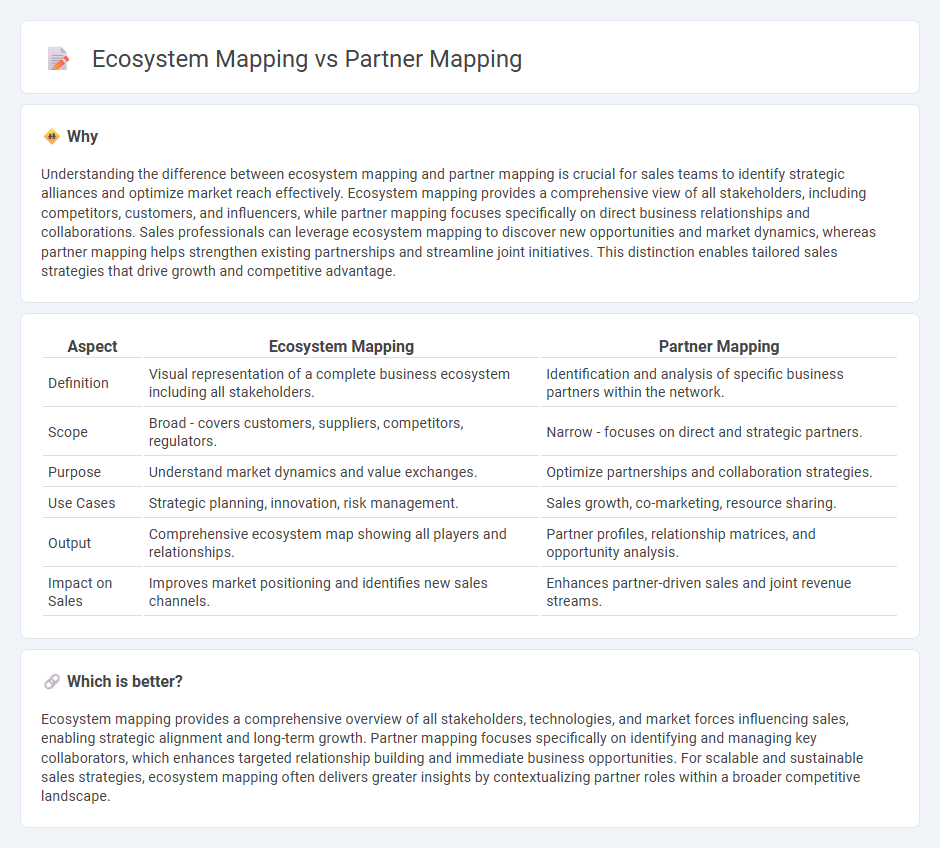
Ecosystem mapping identifies the entire network of interrelated stakeholders, including suppliers, customers, competitors, and regulatory bodies, to understand the broader market dynamics influencing sales opportunities. Partner mapping focuses specifically on aligning strategic alliances and collaborations that directly impact sales channels and revenue growth. Discover how leveraging both approaches can optimize your sales strategy and drive sustainable business success.
Why it is important
Understanding the difference between ecosystem mapping and partner mapping is crucial for sales teams to identify strategic alliances and optimize market reach effectively. Ecosystem mapping provides a comprehensive view of all stakeholders, including competitors, customers, and influencers, while partner mapping focuses specifically on direct business relationships and collaborations. Sales professionals can leverage ecosystem mapping to discover new opportunities and market dynamics, whereas partner mapping helps strengthen existing partnerships and streamline joint initiatives. This distinction enables tailored sales strategies that drive growth and competitive advantage.
Comparison Table
| Aspect | Ecosystem Mapping | Partner Mapping |
|---|---|---|
| Definition | Visual representation of a complete business ecosystem including all stakeholders. | Identification and analysis of specific business partners within the network. |
| Scope | Broad - covers customers, suppliers, competitors, regulators. | Narrow - focuses on direct and strategic partners. |
| Purpose | Understand market dynamics and value exchanges. | Optimize partnerships and collaboration strategies. |
| Use Cases | Strategic planning, innovation, risk management. | Sales growth, co-marketing, resource sharing. |
| Output | Comprehensive ecosystem map showing all players and relationships. | Partner profiles, relationship matrices, and opportunity analysis. |
| Impact on Sales | Improves market positioning and identifies new sales channels. | Enhances partner-driven sales and joint revenue streams. |
Which is better?
Ecosystem mapping provides a comprehensive overview of all stakeholders, technologies, and market forces influencing sales, enabling strategic alignment and long-term growth. Partner mapping focuses specifically on identifying and managing key collaborators, which enhances targeted relationship building and immediate business opportunities. For scalable and sustainable sales strategies, ecosystem mapping often delivers greater insights by contextualizing partner roles within a broader competitive landscape.
Connection
Ecosystem mapping identifies the network of interrelated businesses, customers, and technologies that influence sales strategies, while partner mapping focuses specifically on analyzing potential and existing collaborators within this network. Together, these tools enable sales teams to pinpoint high-value partnerships, optimize resource allocation, and tailor value propositions that resonate with targeted segments. Efficient integration of ecosystem and partner mapping enhances market penetration and drives revenue growth through strategic alliance formation.
Key Terms
**Partner Mapping:**
Partner mapping involves identifying and analyzing key individual collaborators, suppliers, or stakeholders essential to a business's operations and growth. This process highlights direct relationships and value exchanges, enabling companies to optimize resource allocation and strategic partnerships. Explore partner mapping techniques to enhance your collaboration strategies and drive business success.
Channel Partners
Partner mapping emphasizes identifying and categorizing direct channel partners based on roles, strengths, and market influence to optimize sales and distribution strategies. Ecosystem mapping expands this view by analyzing the broader network, including indirect collaborators, technology providers, and market influencers that impact the channel partner environment. Explore how these mapping techniques can enhance your channel partner strategy for sustained growth.
Relationship Strength
Partner mapping focuses on identifying and analyzing individual business relationships based on criteria such as trust, collaboration frequency, and mutual benefits, emphasizing the strength and quality of direct connections. Ecosystem mapping expands this view by visualizing the entire network of interconnected entities, including partners, competitors, and customers, to understand the overall dynamics and interdependencies that influence relationship strength across the system. Explore how relationship strength impacts strategic decisions by delving deeper into partner and ecosystem mapping techniques.
Source and External Links
Partner mapping - HAD - Humanitarian Academy for Development - Partner mapping is the process of gathering data to understand the presence, capacities, and thematic focus of local organizations in a given area to optimize collaboration and avoid redundant efforts.
Relationship Mapping for Public Health - Visible Network Labs - Relationship mapping visualizes networks of partnerships either as a 'bottom-up' focus on direct relationships or a 'top-down' view of the entire ecosystem to enhance understanding of how partners interconnect.
Partner Mapping Software - PartnerTap - Partner mapping software uses CRM data to identify overlapping customers and prospects across partners, enabling targeted co-marketing, sales collaboration, and a holistic market view to drive revenue growth.
 dowidth.com
dowidth.com